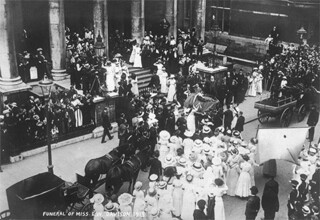A Statue for Emily Davison
Marina Warner
The Wilding Festival, organised by mostly young artists, teachers and activists, took place earlier this month in St George’s Bloombury, the Hawksmoor church which is crowned by a ziggurat and backs on to Little Russell Street, opposite the offices of the LRB. Emily Wilding Davison’s funeral took place there a hundred years ago, the magazine was collaborating with the festival, and I was asked to give a talk about female heroism. I’ve been thinking a lot about the politics of liberty and the effects of martyrdom; Bidisha, who has a book coming out about asylum seekers, and I talked afterwards in a public conversation. In the friendliest way she asked me very hard questions; we didn’t get very far with the problems of feminism, revolution, freedom of speech in the age of pornography, and casual images of death, like the newsreel of Emily Davison’s action, but we tried.
There are some straightforward issues which are smaller and easier to solve. For example very few politically important female figures are remembered in public. Emily Davison’s centenary is part of an ongoing campaign, and one plan is to raise a statue to her in London, near or in the Houses of Parliament, in order to pay tribute to her role in securing the vote for women. Emmeline Pankhurst is already there, on the Embankment; an amiable bronze that covers up her militancy completely. Christabel doesn’t have a statue, but there is another memorial campaign under way for a statue for Sylvia.
I was recently in Szeged, in the south of Hungary, and the square around the vast cathedral is like poets’ corner, covered in memorials wall to wall, but a much larger space and infinitely more various in its scope. Plaques, busts, bas reliefs, many of them with quotations and mottoes, pack the space like a students’ message board; later, as I walked around the elegant 19th-century streets, I found more – fountains, statues, tablets, inscriptions – everywhere. The town was a picture book of its past and people. I hardly recognised a single name, but I liked the feeling of the ghosts clamouring for attention, for passers-by to stop. Siste viator.
However, large bronze effigies on plinths have a way of becoming invisible, as Robert Musil warned: ‘The most striking feature of monuments is that you don’t notice them... You might as well hurl them [great men], with a memorial stone around their neck, into oblivion.’ Can you name any of the figures on the plinths in Portland Place? Or in Waterloo Place, where several great men of history are gathered, alongside Florence Nightingale?
In the case of the women – Emily Davison, Sylvia Pankhurst – let’s not have a bland, reverential effigy (Steven Berkoff is right to sound off in fury against the preening mignon that stands for Laurence Oliver on the South Bank). Let’s have an artist who can make these complicated women visible, face the contradictions of their characters, and who tackles history’s perplexing questions. Someone like Fiona Banner, who brought a Sea Harrier jet into Tate Britain in 2010, or Elizabeth Price, who won the Turner Prize last year with her intense film about the Woolworths fire in Manchester in 1979 in which 11 people died. Or Tacita Dean, who makes film elegies of rare beauty, and has created a personal pantheon (mostly of heroes so far). The suffragettes’ ideals have clear descendants in one current area of activity at least. Even if the cause of women in public life needs so much more action, artists are raising their banners.

Comments